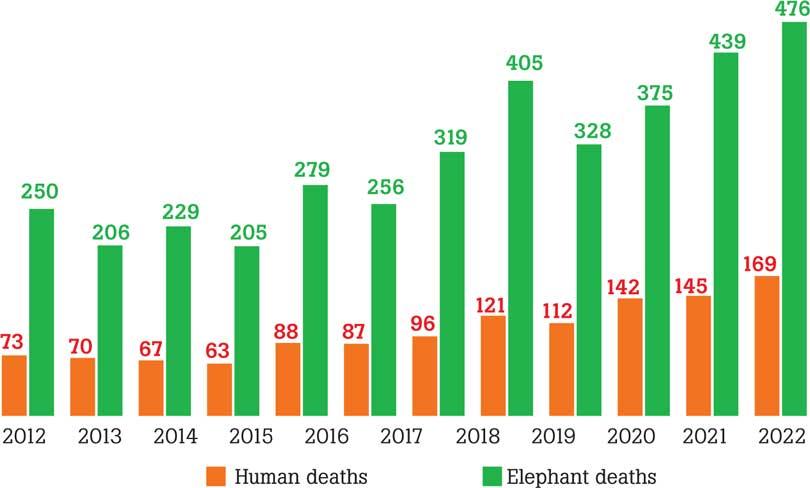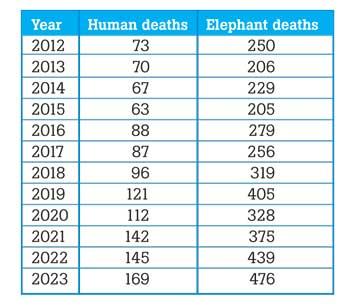09 Jan 2024 - {{hitsCtrl.values.hits}}

According to the First Island-wide National Survey of Elephants conducted in Sri Lanka in 2011, 5879 elephants have been recorded. However, since 2012, 3767 elephants have died according to the
official statistics
 Sri Lanka continues to set the world record for the highest number of elephant deaths due to human-elephant conflict
Sri Lanka continues to set the world record for the highest number of elephant deaths due to human-elephant conflict
Our (Biodiversity Conservation and Research Circle of Sri Lanka) research paper article published in 2020 revealed that Sri Lanka is the country where the highest number of elephants die due to human-elephant conflict in the world (https://www.asesg.org/PDFfiles/2020/51-16-Prakash.pdf). In that scientific publication, we exposed that on average 263 elephants died during 2010-2019.
However, during the last four years 2020-2023, that figure has increased to 405. Hence, it is very clear how fast Sri Lanka’s elephants are becoming extinct from the country.
Sri Lanka, which holds the second place among the countries where the highest number of people die due to human-elephant conflict in the world, continues to be in that position.
 From the year 2020 until now, the number of elephant and human deaths caused by Human-Elephant Conflict (HEC) in Sri Lanka has continued to rise without any control.
From the year 2020 until now, the number of elephant and human deaths caused by Human-Elephant Conflict (HEC) in Sri Lanka has continued to rise without any control.
The number of elephant deaths has been reported as 328 elephants in 2020, 375 elephants in 2021, and 439 elephants in 2022.
In the last year 2023 alone we lost
476 elephants.
We must emphasize that these are only elephant deaths reported to the Department of Wildlife Conservation and another proportion of deaths are taking place unreported.
According to the First Island-wide National Survey of Elephants conducted in Sri Lanka in 2011, 5879 elephants have been recorded. However, since 2012, 3767 elephants have died according to the official statistics.
Therefore, it is far away from the truth to say that the population of elephants; afaunal species with a long gestation period, has increased in a background where sixty-four percent of the elephant population in Sri Lanka has disappeared in 12 years.
Yet, the political authority tries to justify the increasing annual death rate of elephants by issuing such false statements that do not have any scientific basis, and we do not see any effort to control the tragic situation.
Instead, the authorities remain silent when the elephant home range’s destruction and fragmentation continue, escalating the conflict.
More recently, the environment conservationists claim that Pavithradevi Wanniarachchi; the current Minister of Wildlife and Forest Conservation, along with one of her Coordinating Secretary, Balangoda, Allepola, Ranjith Pushpakumara, cleared a 7 km long, over 20-acre forest belt to build an electric fence in the Samanala Lake State Forest.
The day is not far when the politicians and their henchmen will encroach all the lands in this area, where about 400 elephants live, limiting the ‘Managed Elephant Reserve – Hambanthota’ to only a gazette notification and notice boards.
If the Center for Environmental Justice led by senior lawyer Dr. Ravindranath Dabare went before the appeal courts against the land grabbing and massacre of elephants by the chief priest of Nakolagane Rajamaha Vihara Temple in Ehetuwewa Divisional Secretariat Division, Kurunegala, North West Province, the destruction of forests would have continued without any hesitation.
Budget 2024: Agriculture –The President proposes to allocate 300,000 acres from other government lands including State Plantation Corporation, Mahaweli A and B Zones, and Land Reform Commission for large-scale agriculture activities.
During the agriculture section of the Budget speech 2024, President Ranil Wickremesinghe proposed to allocate 300,000 acres from other government lands including State Plantation Corporation, Mahaweli A and B Zones, and Land Reform Commission for large-scale agriculture activities. We do not know how much more elephant home ranges will be damaged and whether the government assessed the impact of such mega-scale projects on human-elephant conflict.
These are just a few examples
Authorities do not seem to be making any genuine efforts to halt the quantitative and qualitative decline and fragmentation of elephant home ranges.
Also, there is no strict enforcement of the law to prevent intentional elephant killings.
According to the report published by the Auditor General of the Government regarding the progress of the Department of Wildlife Conservation during the period 2012-2016, no judicial action has been taken regarding eighty-nine percent of the 384 elephant killings that occurred from January 2015 to October 2017.
Therefore, the general public thinks that it is possible to kill elephants and get off scot-free, and it would be one of the main reasons for killing elephants.That is why the elephants have been shot in the head, cut into pieces, and dumped into the rivers.
We can see that shooting has become the main cause of the death of elephants in Sri Lanka every year.
In addition, electrocution and ‘Hakka Patas’ are the main causes of elephant deaths.
This year alone, more than seventy of the elephant deaths by shooting have been reported.
Also, around fifty elephants have been electrocuted and 40 elephants have died due to ‘Hakka Patas’ this year.
These are all illegal human activities, but it is doubtful whether the Department of Wildlife Conservation, Sri Lanka Police, and Ceylon Electricity Board are actively enforcing the law against the accused.
It should be investigated whether the behaviour of the police and other responsible authorities to harass the rangers who are actively involved in combating wildlife crimes in Sri Lanka has led to the collapse of the rule of law and the rise in wildlife crimes.
This doubt arises when looking at the incident where the death of a hunter took place during an encounter with rangers who were in a raid inside the Lunugamvehera National Park recently.
A Presidential Task Force has not yet been appointed to implement the National Action Plan for the Mitigation of Human-Elephant Conflict three years after its’ submission in December 2020. It was prepared by a Presidential Committee appointed on July 22, 2020, on the instruction of former President
Gotabaya Rajapaksa.
The committee consisted of many experts in the field, university professors, heads of departments, and administrative officers under the chairmanship of Dr. Prithiviraj Fernando, a well-known research scientist on
Asian elephants.
The majority of those who are interested in this area believe that the plan is a positive, practical, realistic, and integrated program to reduce the human-elephant conflict in Sri Lanka. The Committee on Public Accounts (COPA) has also approved it.
It is a matter to be surprised why that the government of a country that appoints presidential task forces even for loud noises,does not do that to manage the human-elephant conflict, which is the most complex socio-economic, environmental and political problem in the country, spread over 131 divisional secretariat divisions in 19 districts of eight provinces of the island, despite a
loud noise.
Instead, President Wickremesinghe has appointed a Presidential Committee, headed by former Director General of Wildlife Conservation, Dr. Sumith Pilapitiya, to facilitate and oversee the implementation of the National Action Plan to Mitigate Human-Elephant Conflict last year, which has also become a white elephant due to not providing the expected powers and funds.
Instead, authorities are wasting time, effort, and resources in a failed attempt to implement human-elephant conflict management plans that are more than six decades old, and humans and elephants go out of the frying pan into the fire.
The previous approach to elephant management and human-elephant conflict mitigation was formulated in 1959 and prescribed limiting elephants to designated protected areas. Despite dedicated efforts by the Department of Wildlife Conservation, after 60 years of pursuing this goal, today 70% of the elephant range is in areas with resident people. However, when we look at the government’s current approach it is clear that again and again, they aim to confine elephants to protected areas.
It has been experimentally proven that all the efforts implemented to do so to date are unscientific and outdated.
Therefore, it should be examined whether the government remains silent while the number of elephant deaths is rising uncontrollably because they expect to eradicate all the elephants outside the protected areas.
The human-elephant conflict has now spread to more than half of Sri Lanka and almost the entire dry zone has been affected. The human-elephant conflict has continued to worsen in recent years. Therefore, we question the authorities whether this lethargy will end in the extinction of elephants; the minority parties of the conflict, form most of the parts of the country.
(The writer is an environment conservationist and researcher)
06 Jan 2025 20 minute ago
06 Jan 2025 1 hours ago
06 Jan 2025 1 hours ago
06 Jan 2025 1 hours ago
06 Jan 2025 1 hours ago